It has been a long time since I started as a beginner Tae Kwon Do student. Over the years I have learned about what is important to me in a Tae Kwon Do school or training facility (dojang) and have put together a short article on best practices you can use when screen Tae Kwon Do schools for the best and most appropriate place for you. I’ve met with several students who have found themselves years later wishing they had made other choices and I’m hoping to help you make a good, educated decision. You never know where you might be in the future — I never thought I’d still be training hard and teaching as a Fourth Dan (degree black belt) over a decade after I had begun. Continue reading How to Find a Good Tae Kwon Do School
Location and Directions
The SMS Tae Kwon Do School is conveniently located at 146 W.29th Street, 11th Floor Suite 11ER, between 6th and 7th Avenues. It is just a few blocks south of Penn Station, one block from the 28th St. subway station and just 3 short blocks from Penn Station and most major subway lines. Our telephone number is (212) 268-4300.
Local subways
1, 9: 28th St. stop, 1 block north of the station.
2, 3, A, C, E: 34th Street / Penn. Station. Exit at 7th Ave. and walk south to 29th St.
B, D, F, N, R: 34th St., walk south on 6th Ave. to W.29th St., make a right and walk one block.
One Step Sparring – 1
| One Step Sparring is a controlled exercise where the attacker only takes one step throwing one punch. The response varies depending on which number is called. While each One Step Sparring is unique, they all begin the same way (see below). | ||
 |
||
| The attacker (the figure on the right) prepares to step forward and throw a single punch. Depending upon the 1-Step Sparring number called, it will either be a low punch, middle punch, or face punch. The figure on the left prepares in ready stance. | ||
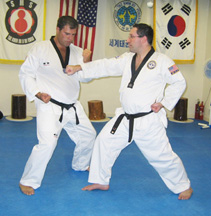 |
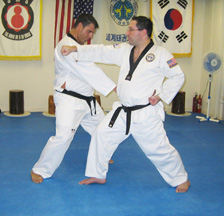 |
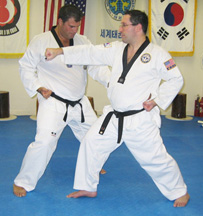 |
| Attack: Middle punch | ||
| Response: Step to the side at a 45° angle into a Ju Chum Seo stance, inside block the attack, then double punch into the side. | ||
Grand Master Kyung Sup Kim
Grand Master Kyung Sup Kim is the owner, operator and instructor of the SMS Tae Kwon Do school in New York City. He has been teaching students of all ages and nationalities for over forty years, instructing both traditional and modern forms in the style of the World Tae Kwon Do Federation. The school has been in operation for over twenty years in midtown Manhattan and is a proud member of The World Tae Kwon Do Federation.
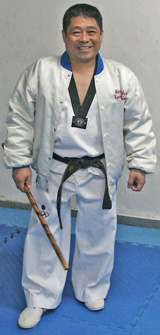 Master Kim has been a pioneer and influence in the development of Tae Kwon Do in Korea, the United States and internationally. He trained under the instruction of Lee Byung Ro and renowned Grand Master, Chong Woo Lee, who was also an original director of the Korea Tae Kwon Do Association, the first official Tae Kwon Do organization. Master Kim has followed in the martial arts tradition of learning and perfecting skills for healing the body. He is also an expert in acupuncture, acupressure, meditation and oriental herb remedies.
Master Kim has been a pioneer and influence in the development of Tae Kwon Do in Korea, the United States and internationally. He trained under the instruction of Lee Byung Ro and renowned Grand Master, Chong Woo Lee, who was also an original director of the Korea Tae Kwon Do Association, the first official Tae Kwon Do organization. Master Kim has followed in the martial arts tradition of learning and perfecting skills for healing the body. He is also an expert in acupuncture, acupressure, meditation and oriental herb remedies.
Master Kim is instantly recognizable on Korean Way in midtown Manhattan, not just as a regular face but also memorable for his unusual lack of height. While he is short in stature, his booming voice and extraordinarily powerful hands more than compensate. You can read his inspirational story, which was published in the Tae Kwon Do Times in September 1996.
One Step Sparring – 2
Attack: Middle Punch
Response: Step to the side at a 45° angle into a Ju Chum Seo stance, 2 hand chop – one to the collar bone and one to the wrist of the attacker’s punching arm. Step into a forward stance and chop down on the wrist again.
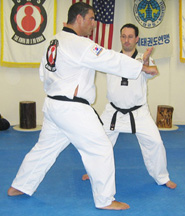 |
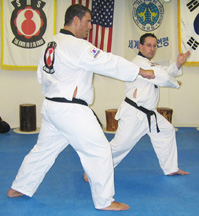 |
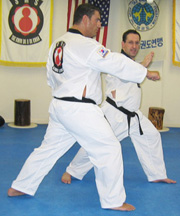 |
Belts and Required Poomsae
The SMS Tae Kwon Do School teaches both the Pal Gwe and Tae Guk poomsae (patterns) in the manner of the WTF (World Tae Kwon Do Federation). There are 20 patterns in total, which must be learned prior to reaching the level of black belt. Master Kim does not believe in requiring formal testing dates for patterns and belt elevation. Master Kim continuously tests his students in every facet of their performance. He decides whether a student has completely mastered the required poomsae and techniques, including possessing the requisite level of skill in all other areas of training in order to progress to the next level.
| White belt |
|
| Yellow belt |
|
| Green belt |
|
| Purple belt |
|
| Brown belt |
|
| Black belt |
|
| First Dan |
|
| Second Dan |
|
| Third Dan |
|
| Fourth Dan |
|
| Fifth Dan |
|
| Sixth Dan |
|
| Seventh Dan |
|
| Eighth Dan |
|
| Ninth Dan |
|
Class Picture
Class Picture
What is Tae Kwon Do?
What is Tae Kwon Do?
Taekwondo is one of the most systematic and scientific Korean traditional martial arts, that teaches more than physical fighting skills. It is a discipline that shows ways of enhancing our spirit and life through training our body and mind. Today, it has become a global sport that has gained an international reputation, and stands among the official games in the Olympics.
Let’s take a closer look at the meaning of the word “Tae” “Kwon” “Do.” It is composed of three parts as shown in the English spelling, though it is one word in Korean. “Tae” means “foot,” “leg,” or “to step on”; “Kwon” means “fist,” or “fight”; and “Do” means the “way” or “discipline.” If we put these three parts together, we can see two important concepts behind “Tae Kwon Do”.
First, Taekwondo is the right way of using Tae and Kwon ‘fists and feet,’ or all the parts of the body that are represented by fists and feet. Second, it is a way to control or calm down fights and keep the peace. This concept comes from the meaning of Tae Kwon ‘to put fists under control’ [or ‘to step on fists’]. Thus Taekwondo means “the right way of using all parts of the body to stop fights and help to build a better and more peaceful world.”
Taekwondo has been developing with the 5000-year long history of Korea, being called by several different names in the course. In Korea, Taekwondo began as a defense martial art called “Subak” or “Taekkyon,” and developed as a way of training body and mind in the ancient kingdom of Koguryo, under the name of “Sunbae.” In the Shilla period, it had become the backbone of Hwarangdo that aimed at producing leaders of the country.
Taekwondo today is similar to the martial arts in other Oriental countries and shares some features with them, because in the course of its evolution it has gained many different styles that existed in the martial arts of the countries surrounding Korea, like Japan and China.
But Taekwondo is very different from many such oriental martial arts. First, physically it is very dynamic with active movements that include a mirage of foot skills. Second, the principle physical movements are in simpatico with that of the mind and life as a whole. Third, it possesses dynamic poses from another perspective.
Taekwondo can be characterized by unity: the unity of body, mind, and life, and the unity of the pose [“poomsae”] and confrontation, and cracking down. When you do Taekwondo, you should make your mind peaceful and synchronize your mind with your movements, and extend this harmony to your life and society. This is how in Taekwondo the principle of physical movements, the principle of mind training, and the principle of life become one and the same. On the other hand, the right poomsae lead to the right confrontation, which will eventually produce great destructive power.
How come we reach such a unity in Taekwondo? Taekwondo is a way of life, much like having a job, raising a family, fighting for a cause, or any one of numerous raison d’etre. What makes Taekwondo different from these is that it is an activity for survival in extremely antagonistic situations. One must always overcome the enemy that is trying to cause harm. But simply winning a fight is not enough to guarantee one’s safety, because the enemy may recuperate and attack again. Moreover, there may be many other enemies than the one that was just defeated. One cannot ever feel safe unless one gains permanent peace. To attain this permanent or lasting peace, one needs unity. This is what Taekwondo aim for. Otherwise Taekwondo would be no different from any other street-fighting skills.
Taekwondo pursues harmonious growth and improvements of life through its unique activities. This is why one could say Taekwondo is a way of life. To ultimately enable ourselves to lead more valuable lives, we would do well by finding the guiding principles deeply hidden in Taekwondo.
One Step Sparring – 3
Attack: Middle Punch
Response: Walking step forward, inside block. Spin around and hit the temple with a backhand.
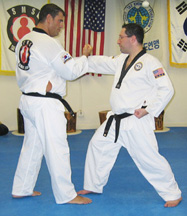 |
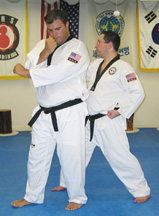 |
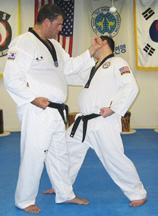 |
One Step Sparring – 4
Attack: Middle Punch
Response: Response: Step to the side at a 45° angle, chop down on the wrist of the punching arm. Grab and rotate the wrist, using your thumb to go slightly underneath the wrist for leverage to twist the hand and arm. Twist the hand and arm, which well bend your opponent over slightly and deliver a roundhouse kick to the stomach (kyop!) Follow this roundhouse kick with a downward low side kick to the inside of the knee. Step down with your right foot, bring your left foot over so you are practically behind your opponent, fully twist the arm up and behind the back.
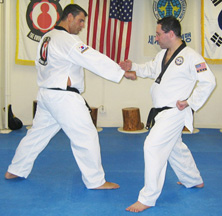 |
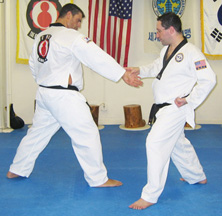 |
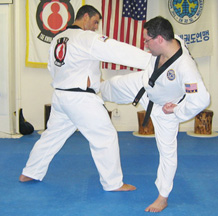 |
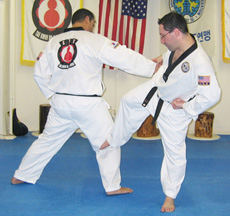 |
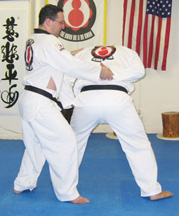 |